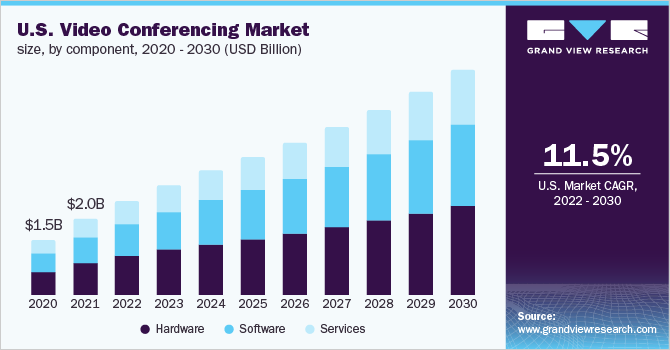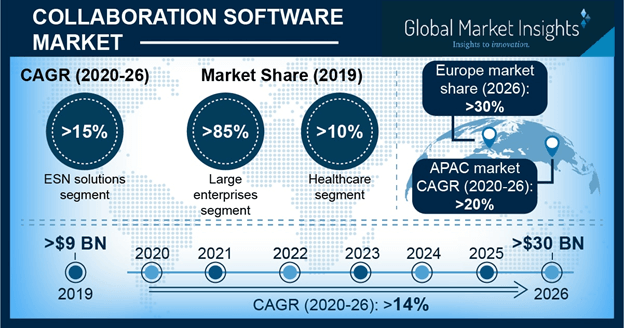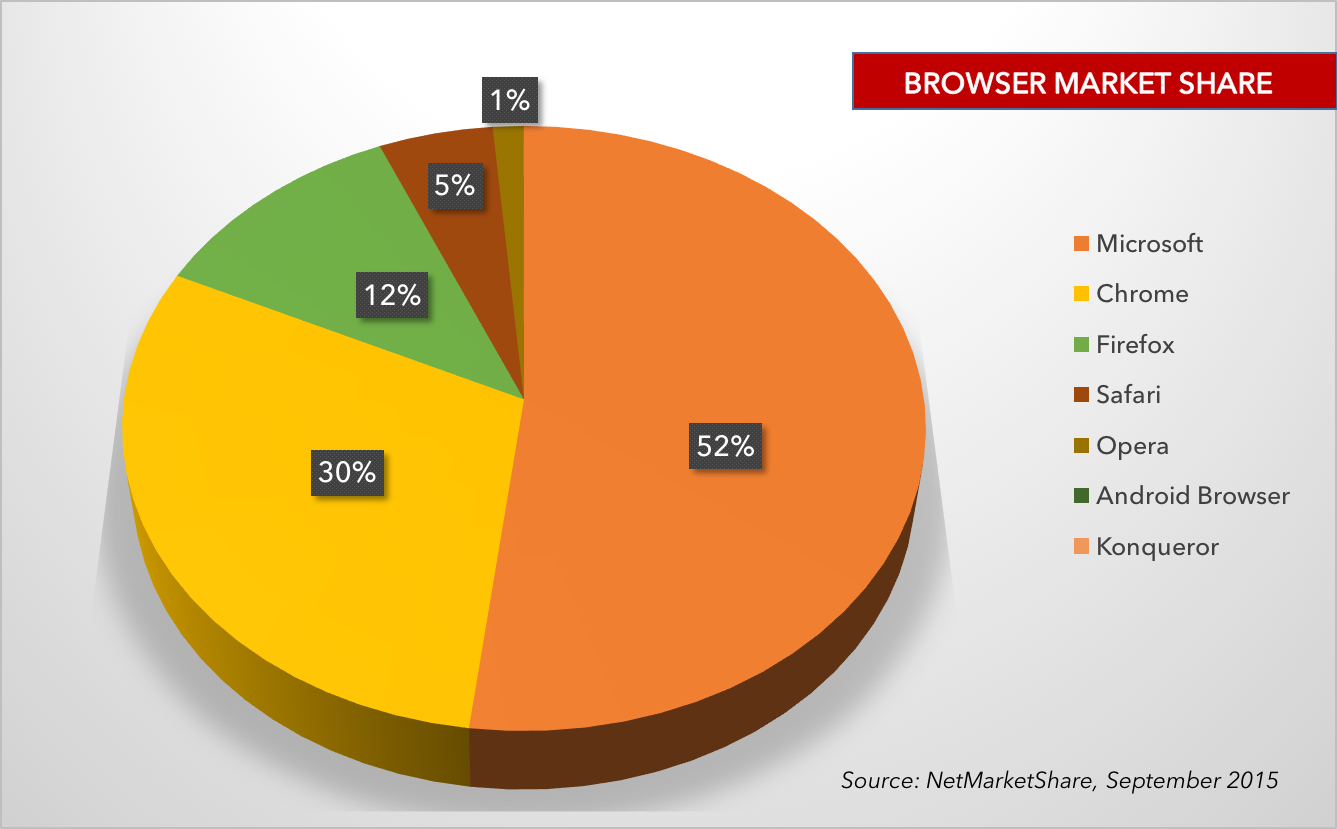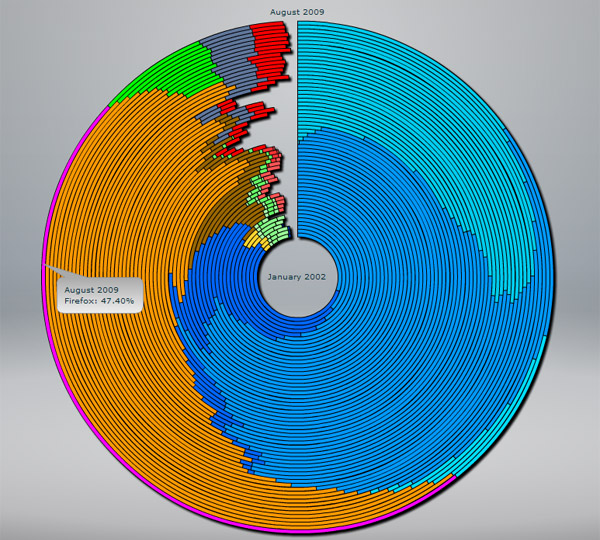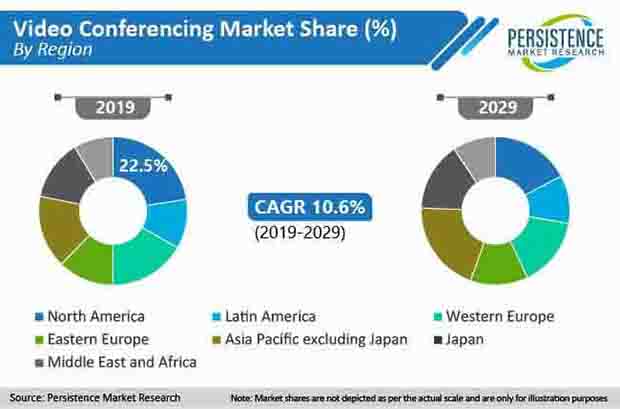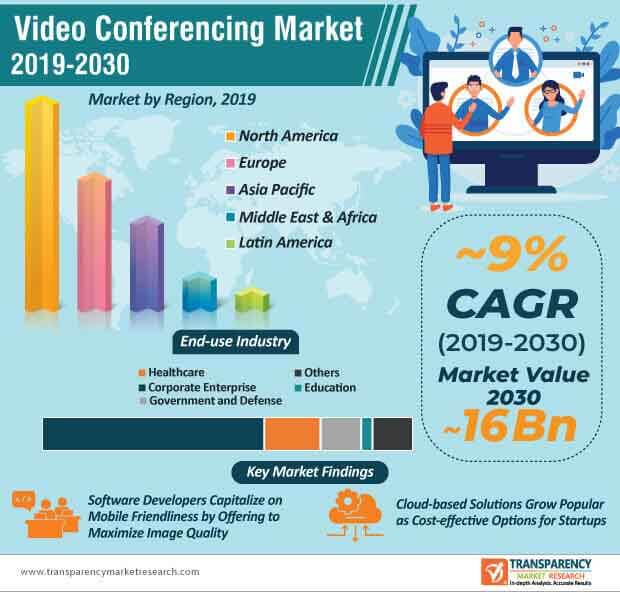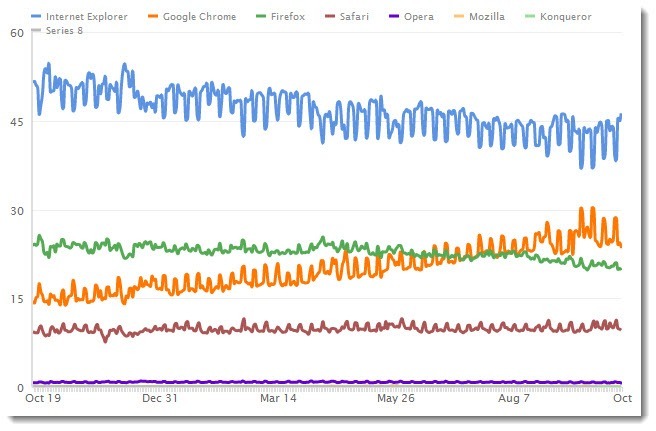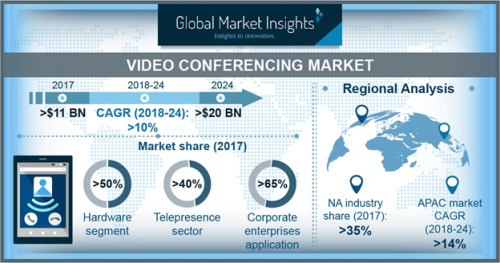The global video conferencing market was dominated by the corporate enterprise's segment in 2019, with market share, in terms of revenue, of over 40% of the overall market. The corporate enterprise segment comprises business organizations across different industry verticals such as IT and telecommunication, banks, financial services, and insurance , business process outsourcing organizations, and others. With the growing globalization of business enterprises, the need for effective video collaboration is predicted to remain strong thereby leading to the dominance of the segment throughout the forecast.
Nevertheless, due to the increasing penetration of IT-based services in the healthcare industry, the healthcare segment is projected to register the highest growth in the coming years globally. Apart from healthcare, education is another lucrative segment expected to register high growth in the global video conferencing market in the coming years. Further, segments such as government & defense and media & entertainment are expected to witness steady growth during the forecast period.
This is attributed to the fair penetration of video conferencing solutions across the segments. The demand for video conferencing solutions in the government & defense segment is mainly backed by the federal governments and judiciaries in major countries worldwide. The said research study covers in-depth analysis of multiple market segments based on deployment models, end-users, and cross-sectional study across different geographies.
The revenue estimates for Government & Defense segment have been evaluated considering different types of government viz. The market, on the basis of the deployment model, has been evaluated considering the basic components i.e. hardware, software, and services. In order to help strategic decision-makers, the report also includes competitive profiling of the leading video conferencing solutions vendors, their SCOT analysis, market positioning, and key developments. In 2019, the global video conferencing market was dominated by the on-premise video conferencing deployment model with market share of over 50% of the total market revenue. The on-premise deployment model consists a complete solution including hardware and software required for video conferencing setup.
This makes on-premise mode of deployment costlier as compared to the other modes of deployment. Popular hardware required for installation of video conferencing setup includes servers, network infrastructure, video screens, cameras, audio systems and other accessories. On-premise deployment model segment is largely backed by the large corporate enterprises and government & defense segments where the consumers have high budgets coupled with high reliability requirement. The penetration of cloud-based video conferencing solutions is majorly due to their low costs, flexibility and ease of scalability as compared to the on-premise video conferencing solutions. In addition to this, the demand for cloud-based video conferencing solutions is also supported by the increasing emergence of small and medium enterprises worldwide.
In emerging economies such as India and China, the demand for cloud-based video conferencing solutions is expected to remain high in the following years. In addition to this, organizations look for cost effective solutions that can fulfil their need seamlessly. Thus, healthcare and education segments are expected to emerge as the most promising segments for video conferencing market in the following years. Additionally, with growing shift towards cloud-based solutions, the market for cloud-based video conferencing solutions is estimated to expand substantially in the following years. The video conferencing market worldwide accounted for revenue of US$ 5,663.3Mn in 2019. The market is projected to expand with a CAGR of 12.7% during the forecast period from 2020 to 2028.
In 2019, the global video conferencing market was dominated by North America accounting for more than one-third of the total market revenue. The high market share in the region is in the lieu of strong penetration of video conferencing solutions across various industry verticals. North America is among the leading regions, in terms of penetration of video conferencing solutions, in the healthcare industry.
Similarly, Europe accounts for the second-largest share, in terms of revenue, of the video conferencing market worldwide. However, Asia Pacific is poised to register the highest growth in the global video conferencing market in the coming years. The growth is largely expected from China and India due to the high adoption rate of video conferencing solutions across various industry verticals. On the contrary, integration and research of new technologies such as video conferencing software and online conferencing software is expected to decrease the cost. In addition, rise in monthly subscription fees by key vendors, high setup cost of virtual meeting software, and growth in support service charges hamper growth of the market. Furthermore, high additional features cost associated with virtual meeting and rise in cost of different virtual rooms is a major factor that restrains the virtual meeting software market growth.
In addition, surge in adoption of technologies, such as facial recognition, to detect and authenticate meeting participants positively impacts the virtual meeting software market growth. However, high software and hardware cost associated with virtual meeting software is a major factor expected to hamper growth of the market to a certain extent. On the contrary, integration of advanced technology such as artificial intelligence and cloud-based technology are anticipated to offer remunerative opportunities for expansion of the global market during the forecast period. The demand for video conferencing platforms is higher than ever, and the global video conferencing market size is expected to reach $10.92 billion by 2027. By looking at the global search volume, our study revealed the total market share for each video call platform, and compared 2020 vs 2021, to which platforms achieved the most growth during the pandemic.
Adoption of virtual meeting software has increased over time to improve business insights of organizations and to enhance communication between clients and employees. In addition, virtual meeting software helps organizations to connect to large audience and provide high security features compared to video conferencing software owing to which many organizations are shifting to virtual meeting software. Furthermore, many banking and manufacturing industries are investing in virtual meeting software to increase security of their information and data shared online and reduce compliances issues in the organization. In addition, various government agencies are adopting virtual meeting software in the pandemic situation to carry out various routine issues, which include review of budget.
Increase in focus of organizations in expanding their business and managing workforces globally increases the need for virtual meeting software in various organization. Furthermore, various leading players of the market are introducing new software for different industries to increase security features and reduce communication gap between employees and companies. For instance, in April 2020, RegTech start-up Signzy launched its secure Video Conferencing tool for secure, private one-to-one communication between banks, other financial institutions and their customers. In addition, various IT & telecom companies are adopting virtual meeting software to increase business continuity among enterprises to increase their market value, which propels growth of the market. Many government organizations mainly rely on virtual meeting software for their day-to-day operations, which also creates a huge demand for the virtual meeting software market. The global virtual meeting software market size was valued at $7.62 billion in 2019, and is projected to reach $57.23 billion by 2027, growing at a CAGR of 27.6% from 2020 to 2027.
Virtual meeting software is a type of platform, which is used to conduct meetings, group discussions, and any other conversations over the internet. In addition, various companies across the globe are adopting virtual meeting software, owing to its various benefits such as providing fast and secure way of communication within organization, improving communication between employees. Furthermore, virtual meeting software helps organizations to save their operational cost and to improve business relationships with their customers, which increases demand of virtual meeting software. The on-premise segment dominated the video conferencing market in 2020 by capturing a revenue share of over 59%.
This can be attributed to the increasing adoption of on-premise deployment by large organizations in response to the growing concerns regarding data theft and effective maintenance of information security systems. However, the segment is expected to witness slow growth over the forecast period owing to the growing prominence of cloud-based solutions. In response to this trend, companies have also started moving to the cloud revenue generation model. For instance, Avaya, Inc. transformed its revenue generation model from legacy on-premise to cloud. By looking at the global search volume, our study revealed the total market share for each video call platform, and compared 2020 vs 2021, to see which platforms achieved the most growth during the pandemic. By deployment model, the virtual meeting software market was led by the on-premise segment in 2019, and is projected to maintain its dominance during the forecast period.
This is attributed to rise in adoption of on-premise based virtual meeting software by various SMEs, owing to growth in concerns regarding data theft and effective maintenance of information security systems. By all indications, the global web conferencing market is one of the most dynamic in the entire technology world today. The ever increasing demand for the best cloud-based communications solutions and mobile applications among businesses is a significant driver of this growth. The growing appreciation of business mobility and the implementation of Bring-Your-Own-Device policies also advance the web conferencing market share for these tools.
The plunging prices of video and web conferencing products, both software and hardware, are also helping boost this market growth. North America is expected to dominate the global video conferencing market in terms of revenue share in the global market during the forecast period. The global virtual meeting software is segmented on the basis of component, deployment model, enterprise size, industry vertical, and region. In terms of enterprise size, the market is segmented into large enterprises and small & medium enterprises.
By industry vertical, it is divided BFSI, education, IT & telecom, government & public, healthcare, manufacturing, media & entertainment, oil & gas, others. Region wise, the market is analyzed across North America, Europe, Asia-Pacific, and LAMEA. In order to ensure business continuity amidst the COVID-19 crisis, business organizations, especially in highly affected countries are allowing their employees to work from home. The increase in people working from home has led to a surge in demand for online video viewing, downloading, and communication through video conferencing, all of which are leading to increased network traffic and data usage. COVID-19 shall accelerate the demand for agile and flexible work styles and further push the adoption of communication services that tend to improve work-life balance. On the flip side, telecom regulators worldwide have postponed their plans of 5G spectrum auction amidst the global pandemic.
This is expected to have an impact on the commercialization of commercial 5G standalone deployments and revenue generated through 5G services. The ongoing pandemic has forced telecom operators worldwide to test their network resiliency and revisit their planned investments, especially in 5G technology. The enterprise segment dominated the market in 2020 by capturing a revenue share of over 84%.
Conference video endpoints are room-based hardware solutions that are fixed, installed, and configured in meeting rooms and boardrooms. These are all-in-one systems that do not require additional hardware or software, as the codec communicates with other endpoints and transfers video signals and data. The growing trends of implementing video banking solutions owing to the growing penetration of mobile and online banking among users are expected to accelerate the video conferencing market growth.
In addition, video banking allows end-users to communicate securely, and connect with remote clients and coworkers, thereby improving operational efficiency. Hence, there is growing adoption of visual communication solutions in the banking and finance sector for loan officers, consumer service representatives, financial advisors, and many others. Key players are introducing new products to cater to the rising demand for video banking solutions in the banking and finance sector.
The report focuses on growth prospects, restraints, and trends of the global virtual meeting software market analysis. The global video conferencing market size is expected to reach USD 8.56 billion by 2027, expanding at a CAGR of 9.9% from 2020 to 2027, according to a new study conducted by Grand View Research, Inc. Growing usage of these solutions in startups, educational institutes,and organizations, especially in the emerging countries of Asia Pacific, are expected to drive the market. Moreover, proliferation of 4G-enabled mobile devices and rise in the number of Video Conferencing-as-a-Service providers are expected to contribute to market growth. The study provides a crucial view on the web conferencing software by segmenting the market based on type, application, and region.
All the segments of web conferencing software market have been analyzed based on present and future trends and the market is estimated from 2020 to 2026. This report will identify dominating sub-segments in terms of revenue contribution for the base year as well as during the forecast period. The fastest-growing sub-segments with its major growth driving factors are also presented in the report. To give the users of this report a comprehensive view on the web conferencing software market competitive landscape and analysis of Porter's Five Forces model for the market are included in the report. The study encompasses market attractiveness analysis, wherein all segments are benchmarked based on their market size, growth rate and general attractiveness. The report covers forecast and analysis for the web conferencing software market on a global and regional level.
The study provides historic data from 2016 to 2019 along with a forecast from 2020 to 2026 based on revenue . The study includes drivers and restraints for the web conferencing software market along with the impact they have on the demand over the forecast period. Additionally, the report includes the study of opportunities available in the web conferencing software market on a global as well as regional level. North America dominated the market for video conferencing in 2020 and acquired a revenue share of over 39%. The regional market is mature in terms of the adoption of video conferencing solutions. However, growth opportunity lies in the region for upgrades to existing equipment and subscription of cloud-based services.
Increased demand for continuous access to high-quality internet and visual meetings is expected to contribute to regional growth. The presence of several key players, coupled with the growing popularity of Bring Your Own Device solutions, which has resulted in the large-scale adoption of webcams and headphones, is further expected to drive market growth. Region wise, the virtual meeting software market was dominated by North America in 2019, and is expected to retain its position during the forecast period.
This is attributed to increase in demand for visual meetings and continuous access to high-quality internet across North American countries. With the ongoing coronavirus (COVID-19) pandemic and disruptions in large gatherings, demand for remote training is increasing, eventually driving the video conferencing market demand. Several global enterprises including Microsoft Corporation, Google LLC, Apple Inc., Hitachi Ltd., and Amazon have announced mandatory work-from-home policies to prevent the spread of COVID-19. The rapidly increasing cases of virus has necessitated the demand for video conferencing software as business travel, educational institutes, conferences are cancelled globally. The report provides company market share analysis to give a broader overview of the key players in the web conferencing software market. Major players in web conferencing software market are Microsoft Skype for Business, Adobe Connect, Livestorm, Zoho Meeting, Wire, Webinato, WebinarJam, FluentStream, TeamViewer, Facebook Live, Zoom Video Conferencing, among others.
The global market research report highlights leading regions worldwide to offer a better understanding of the user. Furthermore, the report provides insights into the latest video conferencing market trends and analyzes technologies deployed rapidly globally. It further highlights some of the growth-stimulating factors and restraints, helping the reader gain in-depth knowledge about the market. Among these, the solution segment is estimated to hold the largest video conferencing market share during the forecast period.
The growth is attributed to the rising demand for video collaboration solutions such as Zoom, Skype, Microsoft Teams, and others in various industries. The virtual meeting software market has witnessed significant growth in past few years; however, owing to outbreak of the COVID-19 pandemic, the market is projected to exhibit a sudden rise in 2020. This is attributed to the implementation of lockdown by governments in majority of countries and shutdown of various companies across the globe. As a result, various organizations such as IT & telecom, BFSI, manufacturing, and others have adopted virtual meeting software for completing their ongoing projects. In addition, rise in adoption this software in the education and healthcare sector across the globe increases the demand for virtual meeting software.
Furthermore, various corporate offices have adopted different applications such as ZOOM, Microsoft Teams, and Skype for training and managing employees of organizations, which drives growth of the market. With rapidly changing business dynamics, companies are shifting toward cloud applications for maintaining and expanding communication resources in a cost-effective manner. This has helped enterprises to reduce upfront expenses by transferring designing of communication solutions to expert service providers. Companies in the video conferencing market are focusing on software innovations to capitalize growth opportunities. The Asia Pacific regional market is expected to witness the fastest growth over the forecast period.
The sudden shift to the remote working model has increased the demand for collaboration tools, video conferencing equipment, and accessories, thereby boosting the market growth in the region. Furthermore, advancements in mobile broadband technologies, such as High-Speed Downlink Packed-Access networks and WiMAX, in countries such as India and Japan, are expected to accelerate the growth of the regional market. The study presents a thorough analysis of the competitive landscape, taking into account the market shares of the leading companies. These provide the key market participants with the necessary business intelligence and help them understand the future of the web conferencing market.
The assessment includes the forecast, an overview of the competitive structure, the market shares of the competitors, as well as the market trends, market demands, market drivers, market challenges, and product analysis. The market drivers and restraints have been assessed to fathom their impact over the forecast period. This report further identifies the key opportunities for growth while also detailing the key challenges and possible threats. The key areas of focus include the types of cheese in the web conferencing market, and their specific applications in different areas. The report encompasses several factors that have contributed to the growth of the overall Web Conferencing Market in recent years. Among all factors, the increasing number of product innovations has had the highest impact in a direct as well as indirect manner on the growth of the Web Conferencing Market.
Accounting to the massive potential held by the product, companies are investing heavily towards the development of innovative products; a step that is influence by the rising competition in the global market. As a result, several businesses are looking to collaborate with these tech companies with a bid to implementing their services within the organizations. In March 2018, General Motors announced that it has chosen Microsoft's services to drive the collaboration platforms within the organization.
